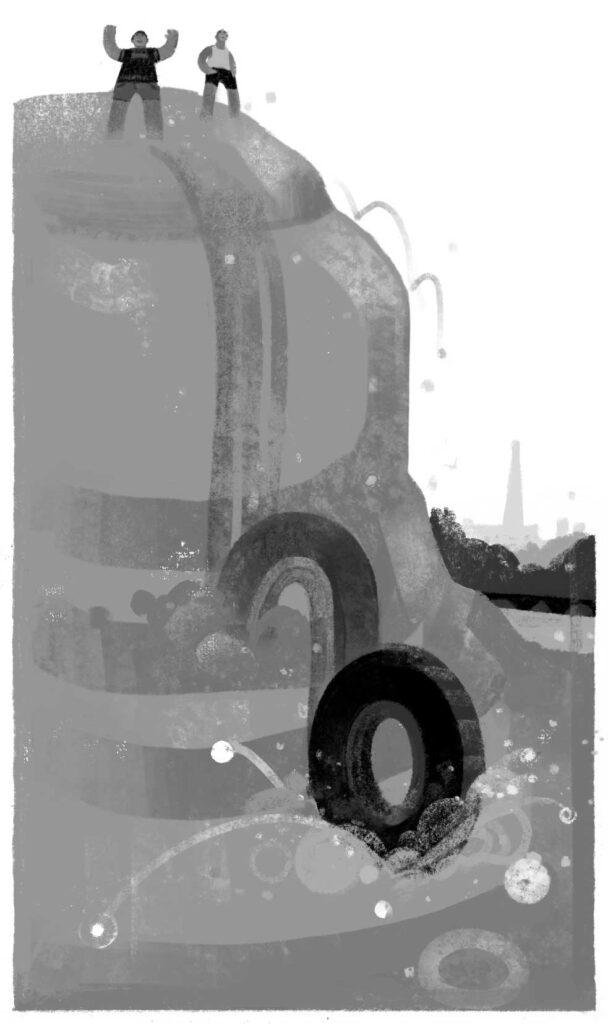Thetford Mines is a blunt name for a town, perhaps the bluntest in Quebec now that its economic twin, Asbestos, has been renamed Val‑des‑Sources. Once dubbed the City of White Gold, Thetford Mines had seven asbestos developments in its vicinity; after the mineral was identified as a carcinogen in the 1980s, they began shutting down, with the last closing in 2012. Sébastien Dulude’s first novel, Amiante (Asbestos), provides an intimate account of growing up in the city during its period of decline, when the ordinary dramas of childhood and adolescence clash against the backdrop of a dying industry.
The first half of this coming-of-age story follows the passionate friendship between the nine-year-old protagonist, Steve, and his classmate Charlélie. The two decorate a makeshift cabin in the woods and read The Adventures of Tintin, while Steve discovers his first pornographic magazine and experiments with masturbation. Such common experiences are juxtaposed against others that are highly specific to place: in this case, the northern ranges of the Appalachian Mountains. An opening scene sees the two boys frolicking in an abandoned mine, where they climb heaps of residue to send a three-metre-tall tire, one of the “relics of the vast armada of BC mining vehicles,” crashing down a slope. As they walk around town, “the fibrous dust of the city of asbestos stirred up under our feet and stuck to our sweat as a grey, chalky film.” Explosions of dynamite, six times a week at 4 p.m. sharp, mark the rhythm of the days and crack the windows of buildings. Such details are Dulude’s real strength. Previously the author of three books of poetry, he crafts images that convey the sensory overload of life surrounded by large-scale resource extraction.

Coming of age in a Quebec mining town.
Sarah Farquhar
It’s clear from the novel’s early pages that not all will be well. The scenes jump back and forth between the summer of 1986 and a more fraught school year, a needlessly complex strategy that nevertheless suggests Steve and Charlélie’s idyll “is in no way eternal.” Steve’s father, a truck driver at the King-Beaver mine, is prone to violent outbursts, both verbal and physical, and his mother battles with depression. Charlélie’s father is a high school teacher, and the relatively cultivated Poulin household provides Steve with an escape into a gentler reality. But the boys also collect newspaper clippings about disasters like Chernobyl and watch the Challenger space shuttle explode live on television in their classroom, observing the “strange and desolate daytime fireworks” alongside teachers too shocked to turn off the broadcast. Such events parallel the mines as warnings about the unforeseen costs of technological advancement and foreshadow the tragic accidents that will shake Steve’s own life. When the second half of the novel jumps forward five years to 1991, Steve the teenager is coping with less abstract forms of loss.
At first glance, Amiante could be mistaken for autofiction. Dulude grew up in Thetford Mines between ages six and sixteen. He has referred to Steve as his alter ego, and his portrait of the boy, broadly coded as queer, calls to mind the French writer Édouard Louis’s exploration of the tension between working-class upbringings and homosexuality. Steve’s father is casually homophobic, mocking his son’s propensity to pick flowers, and his hostility to education converts even his son’s training as a lifeguard into evidence of condescension: “Fourteen years old and already taking himself for a doctor. You’re not going to earn your living watching people in bathing suits, my boy.” This dynamic is so central to the novel that it is surprising to learn that Dulude’s father was on the other side of the class divide: not a truck driver but a lawyer who came to town to help shut the mines down. Charlélie, meanwhile, never existed. Instead of serving autobiography, these invented characters are part of an exploration of masculinity, as the author probes what kinds of relationships are allowed between boys and men and how these boundaries shift between childhood and adolescence. Although Steve’s father risks tipping into caricature, the overall portrait is engaging.
As a teenager, Steve is anxious and alienated, turning to grunge and metal to express his individuality and dreaming that he might “kiss a girl or a boy before the end of high school.” As with J. D. Salinger’s Holden Caulfield, this narrative voice will seem compelling to some and whiny to others. Steve thus laments that his father’s decision to give him a dirt bike for his birthday reflects “a love isolated from my identity.” At one point, he uses a eulogy to explore his own trauma. His new friend Cindy, a parallel figure to Charlélie, is two years older and already at cégep. Her budding anti-capitalism spurs Steve to a more politicized understanding of his hometown and the exploitation on which it is built. The result is resentment and a thirst for destruction: “I imagine the mine’s hole covering itself with a great white fire, sealing and cauterizing forever the source of some poison that seems, even if abstractly, to have contaminated my lungs, my blood, and my skin.”
Amiante has been well received in France, where, Dulude suggests, a robust tradition of industrial novels, like Émile Zola’s Germinal, has made his account easily accessible. Indeed, there is a social epic in the background of this story. Back in 1949, Asbestos and Thetford Mines saw prolonged strikes that were later heralded as precursors of Quebec’s Quiet Revolution. Fast-forward a few decades and the miners were no longer heroes but peddlers of a toxic mineral that the world wanted to ban. Dulude does not delve into this labour history, which in any case would have required adult perspectives to be explored fully. But asbestos mining provides a stark example of the problems that stalk all extractive industries, as sources of wealth and destruction, employment and injury.
Steve, the novel implies, will find a way to escape his hometown for Montreal, but his personal development is ultimately less interesting than the setting itself. One could say that Dulude does for Thetford Mines what Kate Beaton’s Ducks: Two Years in the Oil Sands did for Fort McMurray, Alberta: he forces readers to confront the devastated landscapes that fuel our economy and the lives that revolve around them. Fighting the tendency to push such locations to the edge of our national imaginary, Dulude insists that the city built on asbestos is more than just a curious name on a map.
Amanda Perry teaches literature at Champlain College Saint-Lambert and Concordia University.

